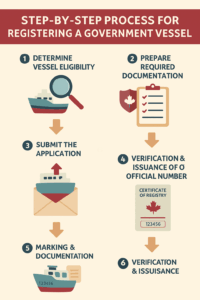The government registration of ships in Canada is fundamental to the enforcement of legal obligations imposed by laws, regulations, government policy, administrative action and functional regulations over vessels owned by public authorities. Government registration is also an affirmation of the ownership of a vessel by the government, and entitlement to reap the benefits of flying the Canadian flag.
Government vessels such as Coast Guard, police department vessels, research or other official vessels owned by provincial and federal agencies are required by law to be registered with Transport Canada’s National Vessel Registry. This is for law enforcement, environmental protection, infrastructure maintenance, and for public visibility and security, and maritime accountability.
The Importance and Fundamentals of Government Vessel Registration
The registration provides public evidence of the status of the vessel as property of the government and entitled to the Canadian flag and all privileges thereunder in Canadian and foreign waters. Registration of a government vessel is also a requirement under the Canada Shipping Act, 2001, the country-specific legislation that governs marine matters such as marine safety and vessel ownership in Canada.
| Aspect | Government Vessel Registration | Private Vessel Registration |
|---|---|---|
| Ownership | Federal, provincial, or municipal body | Individual or corporate |
| Purpose | Public service or research | Commercial or leisure |
| Fee Structure | Often waived or reduced | Based on tonnage or type |
| Registration Authority | Transport Canada | Transport Canada |
| Flag State Benefits | Full diplomatic and legal protection | Standard navigation rights |
Key Objectives of Government Vessel Registration
- Flag: Determines the legal status of the vessel under national law.
- Safety Compliance: Ensures public service vessels meet technical and operational safety standards.
- International Operation: Enables operations in foreign waters under Canadian government authority.
Registration holds the vessel accountable for tracking and regulation.
Registering a vessel makes it subject under MARPOL to binding international conventions like SOLAS (Safety of Life at Sea) at sea.
Step-by-Step Process for Registering a Government Vessel
Registration of government vessels is a routine process that is administered by Transport Canada’s National Vessel Registry.

Step 1: Determine Vessel Eligibility
A government vessel is defined as a vessel completely owned by the Canadian federal, provincial or municipal government that is used for governmental purposes such as research, law enforcement, or public service.
Step 2: Prepare Required Documentation
Documents must verify ownership, vessel specifications, and intended use. Common documents include:
- Proof of government ownership or authorization
- Builder’s certificate or bill of sale.
- Tonnage measurement certificate
- Safety and inspection compliance forms
- Form 1: Application for registration
Step 3: Submit the Application
Applications are submitted via the National Vessel Registry Center, via official channels, and often without a fee from government departments, with the Registrar checking for compliance and accuracy.
Step 4: Verification and Issuance of Official Number
It registers a ship on and receives a Certificate of Registry, which documents the nationality for and owns the flagged vessel.
Step 5: Marking and Documentation
The hull must display the registration number and the name of the vessel and the registration documents must be on board when operating.
These principles help maintain efficiency, transparency, and compliance within Canadian maritime law for all.
Detailed Aspects and Legal Considerations
Compliance with Canadian Maritime Law
Government vessels, whether operating under the authority of Canada or foreign jurisdictions, are also subject to the regulations and requirements of the Canada Shipping Act, 2001.
Key Regulatory Areas Include:
- Vessel inspections and safety certification.
- Compliance with pollution prevention measures.
- Crew requirements in accordance with Transport Canada regulations.
International Recognition and Flag State Rights
The government vessel is registered to the Canadian flag when it is registered, which confers international legal status, diplomatic immunity and treaty rights on such vessels.
Exemptions for Government Vessels
While government vessels are exempt from registration and tonnage charges imposed on commercial vessels, they remain subject to periodic maintenance, inspection, and safety reporting requirements.
Maintenance of Registration
Registrations must be renewed or updated when:
- Ownership is transferred between government departments.
- The vessel is structurally modified.
- Transfer of operational jurisdiction (e.g. from provincial to federal).
- Keeping sufficient records allows for continued legal standing and protection.
Government vs. Private Vessel Registration
| Feature | Government Vessel | Private Vessel |
|---|---|---|
| Ownership Entity | Federal, Provincial, or Municipal | Private individual or company |
| Purpose | Law enforcement, rescue, research | Personal or commercial |
| Registration Fee | Usually waived | Based on tonnage |
| Inspection Frequency | Regular, per Transport Canada schedule | Based on vessel type |
| Certificate Validity | Until ownership or purpose changes | Subject to renewal |
| Flag Display | Canadian Government Ensign | Canadian Red Ensign or private flag |
Efficiency of Vessel Registration Categories in Canada

- The bar graph compares the average processing time taken to register a vessel in Government, Private, and Commercial categories.
- The fastest processing time, 10 days, is for government vessels, which communicate directly between agencies and have little financial verification.
- Private vessels take approximately 20 days due to additional checks and verification of ownership.
- Commercial vessels have the longest processing time (25 days), as they require deeper compliance, safety checks, and business-related verifications.
- Registration time tends to be longer as the type goes from Government → Private →
- The data indicate that operational and financial scrutiny leads to delays in the processing of manifests for non-government vessels.
How to Maintain Compliance After Registration
Regular Inspections and Maintenance
Registered government vessels are periodically inspected for seaworthiness, readiness of safety equipment, and environmental compliance.
Record Keeping
Records concerning ownership, crew personnel lists, and safety inspection results must be retained by departments for audit or regulatory inspection purposes.
Reporting Modifications or Transfers
If you change the name, use or ownership of the vessel, you must inform Transport Canada to keep the registration valid.
Training and Crew Certification
Per national regulations, all members of the crew must have an appropriate Transport Canada approved certification to be on board.
Example:
If a vessel of provincial environmental interest was transferred to a federal department for research purposes, it must be registered under the new owner and purpose.
Best Practices for Efficient Government Vessel Registration
- Centralized Documentation: This would include keeping all ownership, inspection reports, and tonnage in one database.
- Coordinate with Transport Canada: Work directly with federal officials for quick approvals.
- Regular Updates: Review vessel records annually to prevent administrative delays.
- Train Administrative Personnel: Familiarize responsible staff with the procedural and legal framework for registering vessels.
| Practice | Outcome |
|---|---|
| Documentation Management | Faster approval and reduced errors |
| Legal Compliance | Continuous operational readiness |
| Crew Certification | Improved safety and credibility |
| Data Updates | Avoids registration lapses |
Following these practices enhances efficiency and prevents non-compliance issues during audits.
Why Proper Registration Strengthens Maritime Governance
Accurate registration of vessels is integral to Canada’s national security and environmental protection system because it improves traceability, accountability and transparency of government maritime activities.
Benefits Include:
Registered vessels allow easy tracking and auditing because of operational transparency.
- Improved Maritime Security: If someone registers properly, that action prevents misappropriation or operation of government assets without authorization.
- Environmental Stewardship: Comply with air pollution regulations and with water pollution regulations.
- Public trusts: Shows responsible governing and commits to safety.
Canada commits to maritime leadership and environmental stewardship when it registers government vessels.
Ensuring Accountability Through Proper Registration
To summarize, when you register a government vessel at National Vessel Registry Center, you not only decide policy but also process to ensure government accountability, safety, and international recognition. Government departments operate vessels efficiently and lawfully by complying with Transport Canada’s policy and maintaining records as required by the Ship Registration Act and other applicable legislation.
It provides property, marine safety and transparency of public service. With proper maintenance, inspection and regulation, Canada continues to be a world leader in maritime administration.
When registered according to law, the government ship is the sign of confidence, of responsible authority, and of national pride on the seas of the world.

